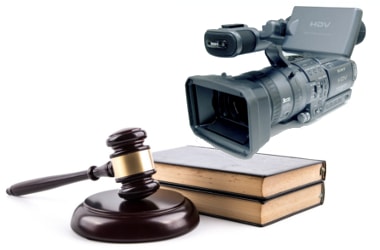As a Televised Impeachment Ends, A Bipartisan Bill to Broadcast Court Proceedings Is Introduced
Legislation Would Require SCOTUS, Appeals Courts to Livestream Audio, Video or Both
 Fix the Court is applauding bipartisan legislation that would require federal appeals courts, including the Supreme Court, to vastly improve broadcast access to their proceedings. The bill, sponsored by a current and a former House impeachment manager, was introduced Thursday as Chief Justice John Roberts swore in U.S. senators on live TV ahead of next week’s televised trial.
Fix the Court is applauding bipartisan legislation that would require federal appeals courts, including the Supreme Court, to vastly improve broadcast access to their proceedings. The bill, sponsored by a current and a former House impeachment manager, was introduced Thursday as Chief Justice John Roberts swore in U.S. senators on live TV ahead of next week’s televised trial.
Currently, federal appeals courts have a hodgepodge of broadcast policies, and only a handful permit live audio or video. The Supreme Court prohibits video and releases argument audio at the end of the week and opinion announcement audio at the start of the subsequent term. The Eyes on the Courts Act would require “real time or near-real time [access] on the Internet” of all appellate proceedings.
“That next week’s impeachment trial will be broadcast live, while the audio of this week’s Supreme Court arguments has yet to be released, is a significant and unnecessary discrepancy in public access among our branches of government,” FTC’s Gabe Roth said. “The work of the Supreme Court and other federal appeals courts has broad implications for the country, and real-time access to their proceedings ought not be limited to the few who can travel to a courthouse and spend hours waiting to get in.”
The bill’s sponsors are leading members of House Judiciary, Chairman Jerry Nadler (D-N.Y.) and Rep. Steve Chabot (R-Ohio); the chair of the panel that oversees the judiciary’s budget, Rep. Mike Quigley (D-Ill.); and the chair of a key oversight subcommittee, Rep. Gerry Connolly (D-Va.) – all of whom are long-time judicial transparency advocates.
The bill differs from other broadcast proposals in that it does not dictate how courts should stream audio or video; it simply compels courts to do one or the other, so long as it’s in “real time” or “near-real time” and is provided online. The inclusion of “near-real time” coverage signals the allowance of a short delay in case there are content or technical concerns.
“The strength of this bill,” Roth added, “is that it offers multiple broadcast options to appeals courts, from live audio to live video to same-day broadcast. Though nearly every court will be required to grant more public access than they currently do, federal judges will still have a meaningful say in how they disseminate their work. This is a smart way to balance the need for greater transparency in the judiciary with latent concerns over separation of powers.”
FTC has long advocated for live broadcasts of federal court hearings, and the organization has worked with partners on Capitol Hill and in the advocacy world to request live or expedited audio or video in high-profile cases more than 30 times in the last three years, with about a 25 percent success rate.
For those requests that were granted, public interest has been demonstrably high. For example, in Trump v. Vance, a Second Circuit case concerning the president’s financial records, which C-SPAN audio-streamed in October, more than 40,000 people listened to arguments within hours of their conclusion. The number quintupled by the next day. When that same case is heard by the Supreme Court in March, the public will be barred from hearing arguments in real time.
Though most FTC requests for expedited audio or video have been rejected, every appeals court has the capability to, at the very least, livestream audio (though only four do), either by plugging in an existing audio feed into their web-based media player and rolling live, as the D.C. Circuit does, or by creating a YouTube page for live hearings, as the Ninth Circuit does.
The Second and Fourth Circuits, which have collectively livestreamed half a dozen arguments in the last three years, simplify the process by permitting C-SPAN to capture and post an audio or video feed. The Supreme Court even has an existing website, livestream.supremecourt.gov, though it’s never been used for oral argument.
Video access to arguments at the circuit level, summarized in this report, has been permitted since 1996, though only the Second, Third, Seventh and Ninth Circuits have ever allowed video, and only the Ninth rolls live. Three district courts that were part of a 14-court pilot program last decade are still permitted to record video of their proceedings.